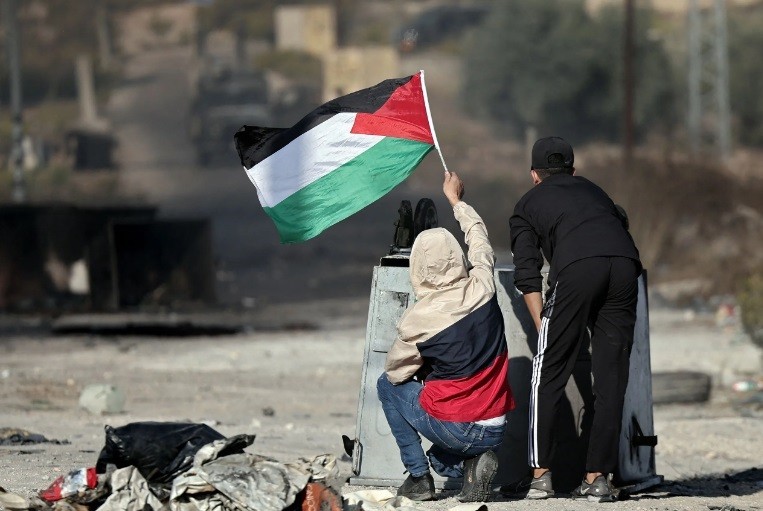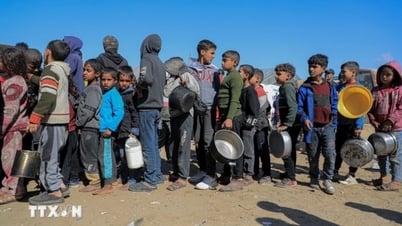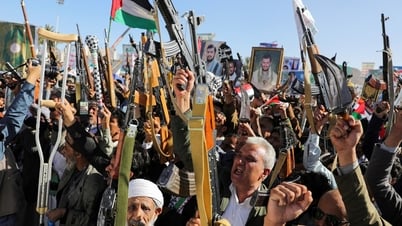More than 100 days after the Israel-Hamas conflict erupted in the Middle East, tensions are still escalating. Moreover, Houthi attacks on shipping in the Red Sea have further complicated the situation. However, many observers believe that a full-scale war in the region is unlikely, largely because neither Iran nor the United States wants it to become a reality.
However, The Economist (UK) said that the economic consequences of the conflict are huge.
 |
| The most dangerous economic consequence of the conflict may be the hardship it causes for people in Lebanon and the West Bank. Illustration photo. (Source: Getty) |
From the heart of the Red Sea
The Red Sea used to handle 10% of all goods moving around the world . However, since the Houthis began firing missiles at container ships in the Red Sea, the volume of shipping through the area has dropped to just 30% of normal levels. On January 16, Shell, the "big guy" in the oil industry, became the latest multinational company to announce it would avoid the Red Sea route.
For some of the countries bordering the region, the Houthi missile attacks have had a much worse effect. Eritrea's economy is fueled largely by exports of fishing, agriculture and mining.
All of these sectors are related to the sea or travel by sea. Meanwhile, in Sudan, a country in crisis, the Red Sea is the only point of entry for aid. Since the attacks, hardly any aid has reached the 24.8 million impoverished Sudanese.
Further disruptions could cause widespread damage to the finances and trade of Egypt, one of the region’s largest countries. With a population of 110 million, the Red Sea is a vital source of income for the country. The Egyptian government earned $9 billion in the 2022-23 fiscal year (through June 2023) from tolls on the Suez Canal, which connects the Mediterranean to the Red Sea.
Without toll revenue, Egypt’s central bank will run out of foreign exchange reserves, which stand at $16 billion, by early 2023. The government will face a huge hole in its national budget, which has relied heavily on cash injections from Gulf states and the International Monetary Fund (IMF).
Both crises for Egypt could hit in 2024. The country’s year-to-date income from the Suez Canal is already 40% lower than it was this time last year, putting it at real risk of running out of money, plunging the government into default and plunging the budget into chaos.
...to the Middle East
According to The Economist, international trade routes are being blocked, disrupting global shipping and devastating local economies. More specifically, the most productive industries in the Middle East are being hit hard. In Lebanon and the West Bank in particular, the hardship is growing and the risk of further violence is growing.
Before the conflict erupted in November 2023, a fifth of the average Middle Eastern country’s exports – from Israeli technology to Gulf oil – were traded within the region. Despite geopolitical rivalries, intraregional trade is growing, a contrast to today, when more than half of all goods have been blocked along these routes.
Intra-regional trade has collapsed. At the same time, the cost of shipping goods out of the Middle East has increased dramatically. That will put many exporters, operating on low profit margins, at risk of bankruptcy in the coming months.
The conflict has also hit the Middle East’s most promising industries. Before October 7, Israel’s tech sector was its brightest spot, accounting for a fifth of the country’s GDP. Now it is beset by hardship. Investors are pulling out, customers are canceling orders, and much of the tech companies’ workforce has been called up to join the military.
Meanwhile, Jordan is facing a neglected tourism industry, a key industry for Jordan, accounting for 15% of its GDP. Even other Gulf states are seeing a dramatic drop in tourist numbers. In the weeks since the conflict began, international arrivals to Jordan have dropped by 54%. Like Egypt, the lost revenue has left the country at risk of near-insolvency.
Two "gunpowder kegs" waiting to explode
The most dangerous economic consequence of the conflict, however, may be the hardship it causes for people in Lebanon and the West Bank, two “powder kegs” that could easily explode into more violence. More than 50,000 people have been displaced (as have 96,000 in northern Israel).
Lebanon has had a caretaker government since defaulting on its debt in 2019. In recent months, the country's economy has plunged into a freefall, as foreign tourists and banks, which together account for 70% of GDP, have fled Lebanon following warnings from foreign governments.
Things are no better in the West Bank. Of the city's 3.1 million residents, 200,000 are factory workers who used to commute to Israel daily for work. They lost their jobs after Israel revoked their permits.
Meanwhile, 160,000 civil servants have not been paid since the conflict began. Public services are shutting down and civil servants' failure to pay mortgages threatens to trigger a banking crisis.
Many economies in the Middle East have long been on the brink. Governments have been building spending programs that balance bailouts from Gulf states, aid from the United States and expensive short-term loans. The risk of it all collapsing is high.
The rest of the world economy has so far suffered little from the conflict. Oil prices have remained relatively stable, with the exception of a spike in early January 2024, and the impact on global growth and inflation is likely to be minimal. However, if much of the Middle East were to fall into debt crisis, things could change rapidly.
Source




![[Photo] Cat Ba - Green island paradise](/_next/image?url=https%3A%2F%2Fvphoto.vietnam.vn%2Fthumb%2F1200x675%2Fvietnam%2Fresource%2FIMAGE%2F2025%2F12%2F04%2F1764821844074_ndo_br_1-dcbthienduongxanh638-jpg.webp&w=3840&q=75)























































![[VIMC 40 days of lightning speed] Hai Phong Port determined to break through, reaching the target of 2 million TEUs by 2025](https://vphoto.vietnam.vn/thumb/402x226/vietnam/resource/IMAGE/2025/12/04/1764816441820_chp_4-12-25.jpeg)





















































Comment (0)